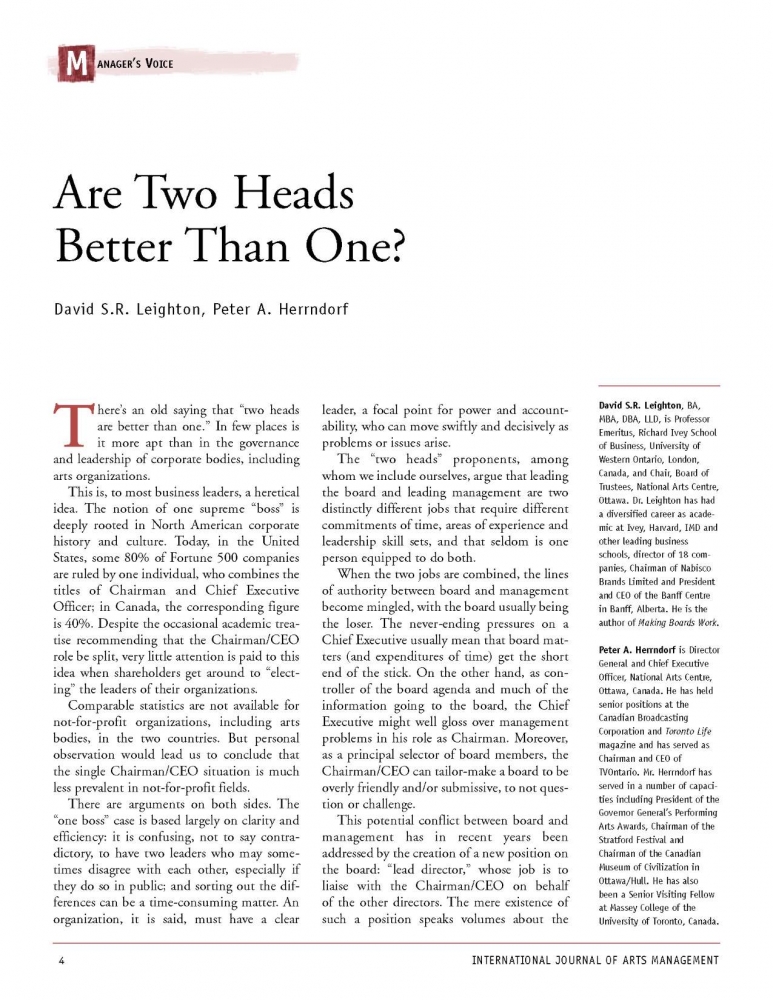Are Two Heads Better Than One?
Produit: Article
21,00 $ CA
David S.R. Leighton, Peter A. Herrndorf
David S.R. Leighton, BA, MBA, DBA, LLD, is Professor Emeritus, Richard Ivey School of Business, University of Western Ontario, London, Canada, and Chair, Board of Trustees, National Arts Centre, Ottawa. Dr. Leighton has had a diversified career as academic at Ivey, Harvard, IMD and other leading business schools, director of 18 companies, Chairman of Nabisco Brands Limited and President and CEO of the Banff Centre in Banff, Alberta. He is the author of Making Boards Work.
Peter A. Herrndorf is Director General and Chief Executive Officer, National Arts Centre, Ottawa, Canada. He has held senior positions at the Canadian Broadcasting Corporation and Toronto Life magazine and has served as Chairman and CEO of TVOntario. Mr. Herrndorf has served in a number of capacities including President of the Governor General’s Performing Arts Awards, Chairman of the Stratford Festival and Chairman of the Canadian Museum of Civilization in Ottawa/Hull. He has also been a Senior Visiting Fellow at Massey College of the University of Toronto, Canada.
ABSTRACT
The leadership of a board, including active participation in the selection of board members and the CEO, is the responsibility of the Chairman. The job of putting together an effective board and developing it as a team is an onerous one, and should not be coupled with the job of actively leading management; the positions of Chairman and CEO should not be combined except in very unusual circumstances. Vital to the division of the two jobs, however, are several conditions: the respective roles of Chairman, board and CEO must be clearly defined and understood; there must be a high degree of mutual respect and understanding between the Chairman and the CEO; the board must feel involved in the operation and have a stake in its success; and the whole process must be layered with communication of the highest order.
KEYWORDS
Governance, board, leadership, arts organizations
RÉSUMÉ
La direction du conseil d’administration, incluant une participation active dans la sélection des membres, incombe au président du Conseil. Former un Conseil compétent et l’amener à devenir une équipe efficace constitue une lourde responsabilité qui ne devrait pas être jumelée à la direction au quotidien d’une entreprise ou d’un organisme; les fonctions de président du Conseil et de président-directeur général ne devraient donc pas être réunies, sauf dans des circonstances exceptionnelles. Toutefois, la séparation des fonctions du PDG et du président du Conseil est assortie de plusieurs conditions essentielles : les rôles respectifs du président du Conseil, du conseil d’administration et du PDG doivent être clairement définis et compris; il faut beaucoup de respect mutuel et de compréhension entre le président du Conseil et le PDG; le Conseil doit se sentir impliqué dans l’entreprise et être intéressé matériellement à son succès; et tout le processus doit reposer sur une communication continue.
MOTS CLÉS
Administration, conseil d’administration, direction, organismes artistiques
RESUMEN
La responsabilidad de dirigir un Consejo de Administración recae sobre su Presidente e incluye el seleccionar a los miembros del consejo y al Presidente Ejecutivo. La tarea de formar un consejo de administración eficaz, y hacer de él un equipo igualmente eficaz, constituye una carga importante de trabajo y no debería sumarse al desempeño de una dirección administrativa activa. No deberían, por lo tanto, acumularse los cargos de Presidente y Presidente ejecutivo, salvo en circunstancias muy especiales. La separación de los cargos de Presidente Ejecutivo y Presidente del Consejo deberá acompañarse de varias condiciones fundamentales: los papeles respectivos del Presidente Ejecutivo, del Consejo de Administración y del Presidente deben estar claramente definidos y entendidos; debe prevaler un alto respeto mutuo y entendimiento entre el Presidente y el Presidente Ejecutivo; los miembros del consejo debe sentirse plenamente involucrados en el funcionamiento del organismo y estar interesados en el éxito del mismo y, finalmente, todo este proceso deberá llevarse a cabo en el marco de una óptima comunicación entre todos ellos.
PALABRAS CLAVE
Gobernabilidad, consejo, dirección, organizaciones culturales
